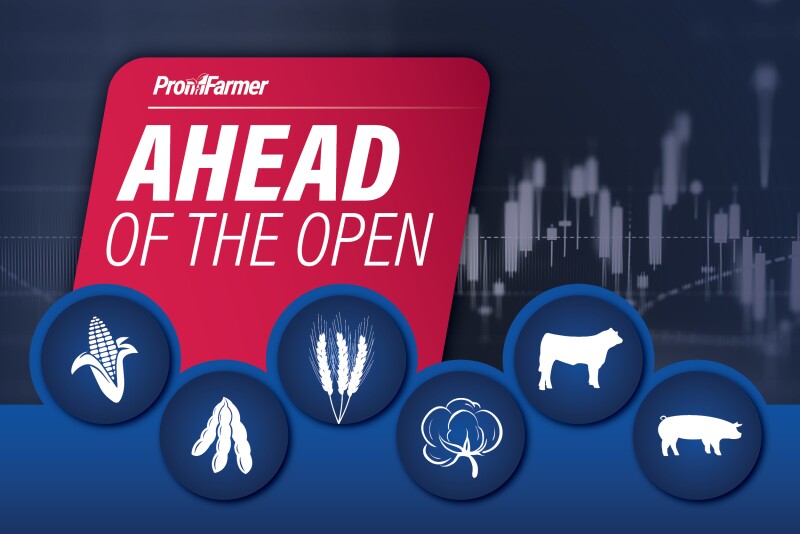GRAIN CALLS
Corn: 6 to 8 cents lower.
Soybeans: 9 to 11 cents lower.
Wheat: SRW 4 to 6 cents higher; HRW 1 to 3 cents higher; HRS 1 to 3 cents lower.
GENERAL COMMENTS: Corn and soybeans led weakness overnight as good crop conditions and a favorable forecast weighed heavily on prices. Wheat saw relative strength. Outside markets are supportive this morning as front-month crude oil futures are modestly higher while the U.S. dollar is around 275 points lower.
USDA rated the corn crop as 73% “good” to “excellent” and 5% “poor” to “very poor,” the soybean crop 66% “good” to “excellent” and 7% “poor” to “very poor” and the spring wheat crop 53% “good” to “excellent” and 14% “poor” to “very poor.” On the weighted Pro Farmer Crop Condition Index (CCI; 0 to 500-point scale, with 500 representing perfect), the corn crop improved 3.5 points to 381.4, which is 9.1 points above last year. The soybean crop slipped 0.9 point to 361.8 and is 1.1 points below year-ago. The spring wheat crop improved 1.1 points to 355.4, though that’s still 26.9 points below last year despite a much better rating in top producer North Dakota. Click here for details.
Tokyo will not sacrifice the agricultural sector as part of its tariff talks with the U.S., top trade negotiator and Economy Minister Ryosei Akazawa reaffirmed, after President Donald Trump complained Japan was not buying American rice. “In negotiations with the United States, our stance remains unchanged: We will not engage in talks that would sacrifice the agricultural sector,” he said, adding that he would continue to negotiate with his U.S. counterparts to protect Japan’s national interests. Akazawa, who is in his seventh trip to Washington for trade talks, declined to say whether rice was part of those discussions.
USDA will reopen ports of entry from Mexico for cattle, bison and equine imports in phases as early as July 7, beginning with Douglas, Arizona, which it said is the lowest risk entry point due to its location and the “long history of effective collaboration” between officials in Sonora and USDA’s Animal and Plant Health Inspection Service. The southern U.S. border was closed to imports of the animals on May 11 for a second time this year due to Mexico’s New World screwworm situation, as the damaging pest was moving northward within the country. The port at Columbus, New Mexico, may reopen on July 14, followed by Santa Teresa, New Mexico, on July 21, Del Rio, Texas, on Aug. 18 and Laredo, Texas, on Sept. 15, USDA said.
CORN: December corn futures broke to fresh contract lows overnight. Support stands at $4.15 then $4.10 on continued selling pressure. Resistance stands at $4.25 then the 10-day moving average at $4.28 on resurgent strength.
SOYBEANS: November soybean futures saw sharp selling overnight. Support comes in at last week’s low of $10.13 1/4 on continued weakness, which is reinforced by support at $10.10. Resistance stands at $10.27 then the 10-day moving average at $10.33 3/4 on a bounce.
WHEAT: September SRW futures continue to consolidate near recent lows. Resistance stands at the overnight high of $5.45 3/4 then the psychological $5.50 mark. Support comes in at $5.36 3/4 on a turn lower.
LIVESTOCK CALLS
CATTLE: Choppy/lower.
HOGS: Choppy/higher.
CATTLE: Live cattle and feeders are expected to open with a mostly weaker tone as the decline in cash cattle prices weighs on futures. Last week’s five-area average was $229.51, marking a $9.40 decline in the past two weeks. That has quickly pushed packer margins deep into the black as wholesale beef remains elevated. Cash cattle are expected to weaken again this week and Friday’s holiday could push trade earlier into the week. Wholesale beef ended Monday mixed as Choice slipped 93 cents to $395.56 while Select climbed $1.17 to $384.10.
HOGS: Lean hog futures are expected to open with a mostly firmer tone as prices are buoyed by technical support, but followthrough selling could limit gains after the open. Traders seemingly anticipated the downturn in cash hogs as futures topped last week. The CME lean hog index is down 26 cents to $111.76 as of June 27, the first daily decline since May 9. July lean hog futures finished below today’s index quote on Monday, suggesting traders sense the seasonal runup has run its course. Pork cutout finished Monday lower, falling $2.09 to $115.37, sharply below the recent peak.

